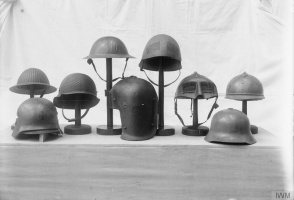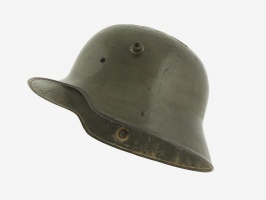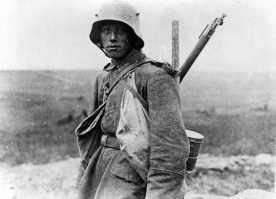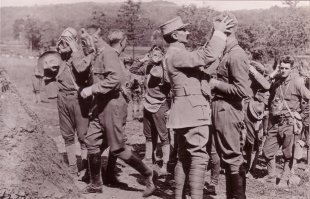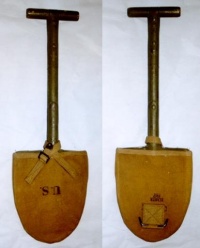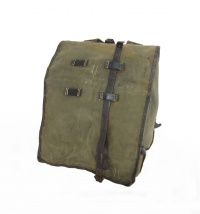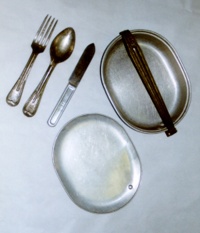Basic Elements of Personal Equipment↑
The various pieces of equipment were usually attached with leather straps to the soldier’s body to allow for quick access. This set of straps formed a relatively stable structure. It was designed not to restrict the man’s mobility and to distribute the weight appropriately.
In the 19th century, a belt became the central element of this equipment. On it were hung ammunition pouches, a sidearm/bayonet, a spade, often a small canvas sack, and sometimes also a holster for a pistol or revolver. Shoulder straps or loops and hooks on the uniform jacket helped to carry the weight of the heavily stocked body strap. The spade was the most important field and survival tool for the soldier, particularly the infantryman. The canvas sack was called a “bread bag” or “bread sack” (Brotbeutel) in Germany and Austria-Hungary, but it was actually a kind of purse, in which many military items, e.g. weapon-cleaning equipment and hand grenades — or personal items — such as tobacco or writing utensils — could be stored.
In Germany, a canteen was attached to the bread bag; in Austria-Hungary, it was carried in the bag itself, while the significantly larger drinking bottles of the English and French armies were hung on the shoulder strap. Each soldier possessed a so-called mess kit, which in practice was used almost exclusively for eating. Hard tack and tinned meat constituted the emergency ration, which was only to be consumed in emergencies or upon orders. An extremely versatile part of the equipment was the tarpaulin, a piece of tightly woven canvas, which could be buttoned to other tarpaulins to form tents, but which was usually used as a sort of poncho for rain protection, or as a makeshift stretcher, sleeping mat, or bivouac sack.
These items composed the essential battle gear. Additional articles of clothing, cleaning materials, spare shoes, and the like were located in a knapsack. Before combat operations, the knapsack was often taken off or, during static warfare, stored in the quarters or dugout. The knapsacks carried by the Central Powers’ armies were intricately made from a frame of narrow wooden bars covered with calfskin. English knapsacks, by contrast, were simple, rectangular canvas sacks. The materials of the Central Powers got noticeably worse as a result of the blockade: brass fittings were replaced with zinc-plated iron; aluminum canteens and mess kits were replaced with ones of steel. Poor-quality woven straps, in some cases even made out of paper yarn, replaced leather. Canvas took the place of the knapsack’s calfskin covers. Starting in 1915, Austro-Hungarian soldiers received backpacks instead of knapsacks.
The personal equipment of the large, continental European conscription armies had evolved over the decades, and so by the outbreak of the war in 1914, the enormous amount of extant supplies made modernization difficult. By contrast, in 1908, the relatively small British army had implemented a completely new, uniformly constructed equipment system which was made entirely without leather. The straps were comprised of high-quality woven material and the individual components were put together in such a way that one could put the equipment on and take it off like a jacket. So outfitted the armies went to war, and their equipment did not fundamentally change until 1918. The special innovations of the war led, however, to the general introduction of two new types of equipment, which ever since have constituted an integral component of soldiers’ personal equipment.
Innovations during the War↑
After 1915, chemical warfare was increasingly employed that affected the eyes, airways, and mucus membranes. Under these conditions, staying in battle zones became impossible without certain protective gear, and gas masks were quickly issued to soldiers. The French army developed a hood-like model which fastened at the throat and was made of chemically-treated canvas. More effective was the German approach of covering the face with a protective mask, through which one breathed via a screw-in, replacable filter. The contents of the filter could then be adapted according to the changing demands of chemical warfare.
Trench warfare yielded an unusually large number of serious head injuries, often caused by small, low-energy grenade shrapnel or secondary shrapnel such as pebbles. As protection against these dangers, the French army in 1915 introduced a steel helmet, whose the form was later adopted by other Allied forces – Russia, Italy, Serbia and Romania. Likewise, in 1915, Great Britain introduced an especially simple-to-manufacture helmet design, but one which was made of high-grade materials. Germany followed in 1916. Steel helmets, however, generally could be pierced by rifle bullets. The new helmets fundamentally changed the soldiers’ appearance, indeed tending toward the heroic. Their shapes quickly developed into national symbols, and from then on characterized the silhouette of the world war soldier in photography and the visual arts.
Dieter Storz, Bayerisches Armeemuseum
Section Editor: Mark E. Grotelueschen
Translator: Rachel Bachmann
Selected Bibliography
- Chappell, Mike: British infantry equipments, 1908-2000, Oxford 2000: Osprey.
- Fisch, Robert W.: Field equipment of the infantry, 1914-1945, Sykesville 1989: Greenberg Publishing Company.
- Kraus, Jürgen: Die deutsche Armee im Ersten Weltkrieg. Uniformierung und Ausrüstung, 1914 bis 1918, Vienna 2004: Militaria.
- Mirouze, Laurent / Dekerle, Stéphane: L'armée française dans la première guerre mondiale. Uniformes, équipements, armements, 2 volumes, Vienna 2007: Militaria.
- Ortner, Mario Christian / Hinterstoisser, Hermann: Die k. u. k. Armee im Ersten Weltkrieg. Uniformierung und Ausrüstung, von 1914 bis 1918, 2 volumes, Vienna 2013: Militaria.





